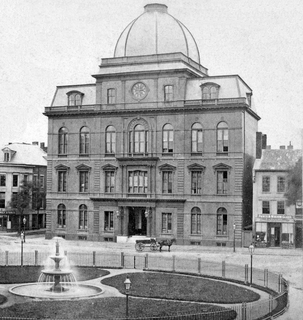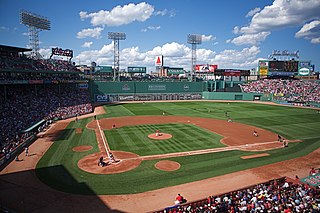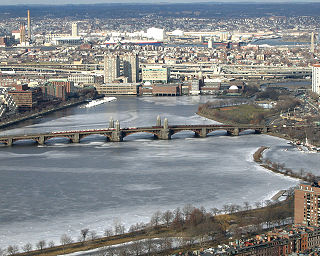
Medford is a city 6.7 miles northwest of downtown Boston on the Mystic River in Middlesex County, Massachusetts, United States. In the 2010 U.S. Census, Medford's population was 56,173. It is home to Tufts University, which has its campus along the Medford and Somerville border. In 2017, Medford’s population grew up to 57,797 residents.

Somerville is a city located directly to the northwest of Boston, and east of Cambridge, in Middlesex County, Massachusetts, United States. As of 2010, the United States Census listed the city with a total population of 75,754 people, making it the most densely populated municipality in New England. As of 2010, it was the 16th most densely populated incorporated municipality in the country. Somerville was established as a town in 1842, when it was separated from Charlestown. In 2006, the city was named the best-run city in Massachusetts by the Boston Globe. In 1972, in 2009, and again in 2015, the city received the All-America City Award. It is home to Tufts University, which has its campus along the Somerville and Medford border.

The Battle of Bunker Hill was fought on June 17, 1775, during the Siege of Boston in the early stages of the American Revolutionary War. The battle is named after Bunker Hill in Charlestown, Massachusetts, which was peripherally involved in the battle. It was the original objective of both the colonial and British troops, though the majority of combat took place on the adjacent hill which later became known as Breed's Hill.
Union Square is a neighborhood in the southeastern part of Somerville, Massachusetts. It is centered on Union Square proper, which is located at the intersection of Washington Street, Webster Avenue, and Somerville Avenue.

The Bunker Hill Monument was erected to commemorate the Battle of Bunker Hill, which was among the first major battles between British and Patriot forces in the American Revolutionary War, fought there June 17, 1775. The 221-foot granite obelisk was erected between 1825 and 1843 in Charlestown, Massachusetts, with granite from nearby Quincy conveyed to the site via the purpose-built Granite Railway, followed by a trip by barge. There are 294 steps to the top.

The Grand Junction Railroad is an 8.55-mile (13.76 km) long railroad in the Boston, Massachusetts, area, connecting the railroads heading west and north from Boston. Most of it is still in use, carrying scrap either inbound or outbound to the Schnitzer scrap yard on the Everett waterfront or freight to the Chelsea Produce Market, and non-revenue transfers of Amtrak and MBTA passenger equipment between the lines terminating at North Station and South Station. The line is also notable for its railroad bridge over the Charles River that passes under the Boston University Bridge between Boston and Cambridge, Massachusetts.

Sullivan Square is a rapid transit station in Boston, Massachusetts. It serves the MBTA's Orange Line, and is also a major bus transfer point. It is located just west of the Sullivan Square traffic circle in the Charlestown neighborhood, adjacent to East Somerville. The modern subway station was built in 1975, and replaced an earlier Charlestown Elevated station established in 1901.

Community College is a rapid transit station in Boston, Massachusetts. It serves the MBTA Orange Line. It is located in the Charlestown neighborhood off Austin Street near New Rutherford Avenue (MA-99), under the double-decked elevated structure carrying Interstate 93 to the Zakim Bunker Hill Bridge. The station is named for the adjacent Bunker Hill Community College, the main population the station serves.
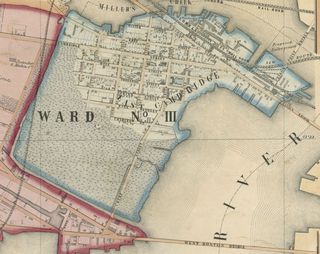
East Cambridge is a neighborhood of Cambridge, Massachusetts. Referred to in modern times as Area 1, East Cambridge is bounded by the Charles River and the Charlestown neighborhood of Boston on the east, the Somerville border on the north, Broadway and Main Street on the south, and the railroad tracks on the west. Most of the streets form a grid aligned with Cambridge Street, which was laid out to directly connect what is now the Charles River Dam Bridge with what in 1809 was the heart of Cambridge, Harvard Square. The northern part of the grid is a roughly six by eight block residential area. Cambridge Street itself is retail commercial, along with Monsignor O'Brien Highway, the Twin Cities Plaza strip mall, and the enclosed Cambridgeside Galleria. Lechmere Square is the transportation hub for the northern side. The southern half of the grid is largely office and laboratory space for hundreds of dot-com companies, research labs and startups associated with MIT, biotechnology firms including Genzyme and Biogen, the Athenaeum Press Building, light industry, an NRG Energy power station, and various small businesses. This half of the neighborhood is generally identified with Kendall Square. Along the waterfront are several hotels and taller apartment buildings.
The Haymarket North Extension is a section of the Massachusetts Bay Transportation Authority's rapid transit Orange Line which currently constitutes the northern section of the line. It runs from North Station through an underground crossing of the Charles River, then along the Haverhill Line right-of-way to Oak Grove station in Malden, Massachusetts. Built to replace the Charlestown Elevated and originally intended to be extended as far as Reading, it opened in stages between 1975 and 1977.

Assembly Square is a neighborhood in Somerville, Massachusetts. It is located along the west bank of the Mystic River, bordered by Ten Hills and Massachusetts Route 28 to the north and the Charlestown neighborhood of Boston to the south. The district's western border runs along Interstate 93. Located 2.5 miles (4.0 km) from downtown Boston, the 143 acres (580,000 m2) parcel is named for a former Ford Motor Company plant that closed in 1958.
The Medford Turnpike is a road mostly in modern-day Somerville, Massachusetts, United States, now known as Mystic Avenue. It was laid out in 1803 as a result of the 1786 Charles River Bridge from Charlestown to Boston. In historic terms, it ran from Medford Center to Charlestown Neck. It is currently designated to be part of Massachusetts Route 38.

Leonard Blanchard Chandler was a Massachusetts businessman and politician who served in the 1917 Massachusetts Constitutional Convention, in both branches of the Massachusetts legislature, both branches of the city council and as the twelfth Mayor of Somerville, Massachusetts.
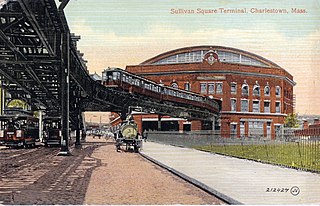
Sullivan Square is a traffic circle located in the Charlestown neighborhood of Boston, Massachusetts. The MBTA's Sullivan Square station is located to the west of the square. Adjacent to the East Somerville area of Somerville, Sullivan Square is named after James Sullivan, an early 19th-century Governor of Massachusetts. In the early 2000s, the Sullivan Square Overpass was dismantled, which left a stub approach to Route 99.

Millers River was a river in Middlesex County, Massachusetts. It has since mostly been obscured by landfill and "made land". The small remaining estuary is a remnant of wetlands and open water that once divided Cambridge from Charlestown, Massachusetts.

East Somerville is a planned light rail station on the MBTA Green Line "D" Branch in Somerville, Massachusetts. The station will consist of one island platform, which will serve the "D" Branch's two tracks.
The following is a timeline of the history of Somerville, Massachusetts, USA.


